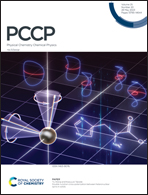Intrinsic point defects and the n- and p-type dopability in α- and β-Bi2O3 photocatalysts
Abstract
In this work, all kinds of intrinsic point defects, unintentional N and H impurities and possible complex defects between impurities and native defects in α- and β-Bi2O3 with different growth conditions are systematically investigated using hybrid density functional calculations. And then, the n- or p-type doping mechanisms in α- and β-Bi2O3 are explored and discussed. It is found that α-Bi2O3 presents the n-type conductivity under O-poor conditions. The unintentional H interstitials as the shallow donors should be majorly responsible for the n-type conductivity character. While under O-rich conditions, α-Bi2O3 displays the p-type conductivity, and the unintentional complex defects VBi1 + 2H as the shallow acceptors should be the primary origins of the p-type conductivity. The hydrogenation of the Bi vacancy in α-Bi2O3 not only significantly lowers the formation energy of the Bi vacancy but also markedly decreases its acceptor transition level. This well explains the experimental observation that α-Bi2O3 changes from n-type to p-type conductivity with increasing O partial pressure. Compared to α-Bi2O3, β-Bi2O3 always presents the n-type conductivity behaviour regardless of the growth conditions. The native O1 vacancies (VO1) and unintentional H interstitials in β-Bi2O3 are shallow and excellent donors. They are responsible for the n-type conductivity and further perfectly explain the observed unintentional n-type conductivity character in β-Bi2O3 experiments. Understanding the defect physics in α- and β-Bi2O3 could inspire more significant studies on developing Bi2O3-based photocatalysts.



 Please wait while we load your content...
Please wait while we load your content...